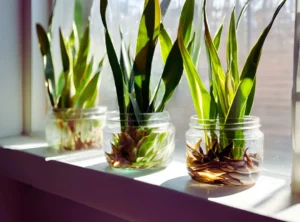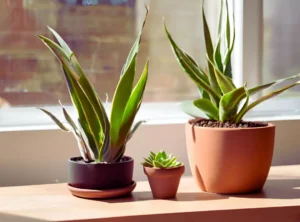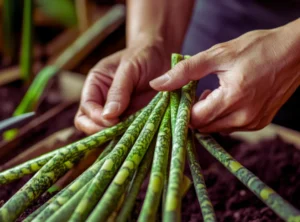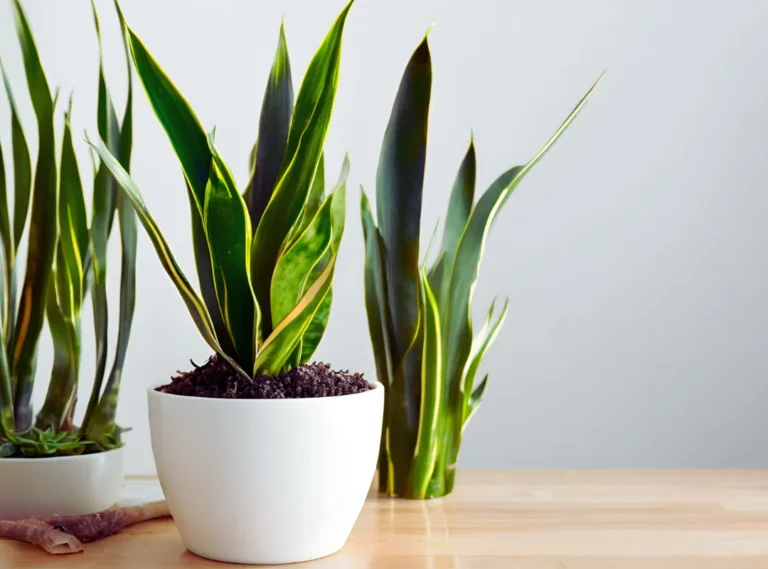Learning how to propagate a snake plant is a rewarding skill for plant lovers, especially since snake plants—with their stunning upright leaves and indestructible nature—are so popular.
Why Propagation is Important for Snake Plants
Benefits of Propagating Snake Plants
Propagation isn’t just a cool science experiment for plant lovers—it’s also an easy way to multiply your favorite snake plant (also called Sansevieria). First off, it’s cost-effective. Instead of heading to a plant shop for more, you can create new plants at home. Moreover, propagating helps rejuvenate an older, scraggly plant, encouraging fresh growth. In addition, sharing your propagated plants makes thoughtful, personal gifts for your plant-loving friends.
Another major perk is sustainability. By growing more plants from a single parent, you’re contributing to a greener environment—literally! Plus, with houseplants making a huge comeback in home décor, propagation is an excellent way to keep your space looking lush without breaking the bank. If you’re curious how to propagate a snake plant, it’s simpler than you might think and perfect for beginners.
Common Reasons for Propagation
So why do people propagate snake plants? Well, it might start with a broken leaf (oops!) or an overgrown pot begging for some breathing room. Many gardeners propagate to save struggling plants. For instance, if your snake plant’s roots are rotting or a part of it is damaged, cutting and propagating the healthy parts ensures survival. Some simply propagate because they love experimenting with plant growth—and let’s face it, watching those roots grow is pretty fascinating!
Who Should Propagate Snake Plants?
Ideal Scenarios for Plant Enthusiasts
Propagation isn’t just for those with green thumbs. If you’re someone who enjoys adding life to your indoor spaces, this is for you. Maybe you’ve been eyeing that corner of your room that could use a little greenery. Or perhaps your snake plant is thriving so much it’s outgrowing its pot. Propagation lets you turn one gorgeous plant into several, ready to adorn new corners, windowsills, or tabletops.
This method is also perfect for those who’ve recently caught the gardening bug. It’s low-risk, doesn’t require fancy tools, and works for small or large spaces alike. Plus, it’s a fun way to bond with fellow plant parents.
Beginners vs. Experienced Gardeners
Beginners often hesitate to start propagating because it sounds complicated—but trust me, it’s easier than it seems! Snake plants are extremely forgiving, so even if you mess up, they’re likely to bounce back. Experienced gardeners, on the other hand, might enjoy the challenge of testing out different methods, like water or soil propagation, or dividing rhizomes for faster growth.
No matter where you fall on the expertise spectrum, there’s a method of propagation suited to your skills and patience level.
Key Facts About Snake Plants
Unique Characteristics of Snake Plants
Snake plants are like the superheroes of the plant world. Known for their upright, sword-like leaves that can grow several feet tall, these plants are incredibly hardy. They can thrive in both low-light corners and bright, indirect light spots. What’s even cooler is their ability to purify the air—NASA-backed studies have proven that snake plants remove toxins like formaldehyde and benzene from indoor air.
One of their standout traits is their slow-growing but steady nature. Unlike some plants that need constant pampering, snake plants thrive on occasional neglect, making them ideal for busy folks or forgetful plant parents.
Why Snake Plants are Easy to Propagate
If you’re looking for a plant that’s a breeze to propagate, you’ve found it. Snake plants don’t require fancy setups or delicate handling to sprout new roots. Thanks to their rhizomes—a type of underground stem—they can reproduce like champs, even in less-than-perfect conditions. Plus, you can propagate them using various methods, from cutting a leaf and sticking it in water to dividing their root clumps.
Common Myths About Snake Plant Propagation
Misconceptions Around Water and Soil Propagation
Let’s bust some myths, shall we? One common misconception is that water propagation weakens plants over time. While it’s true that snake plants are primarily soil dwellers, propagating in water is perfectly fine. In fact, it’s a great way to watch the root growth process up close. Another myth is that soil propagation is “safer” than water propagation—both methods work equally well if done correctly.
Myths About Timing and Growth Speed
Many people think snake plants propagate faster if you cut them during a full moon or in specific weather conditions. While environmental factors like light and warmth help, there’s no magic timing involved. Additionally, some assume that propagation guarantees instant growth. In reality, snake plants take their time—sometimes several weeks or months—to show signs of new life. Patience is key!
Understanding the Basics of Snake Plant Propagation
What is Propagation?
Definition and Importance in Horticulture
Propagation, in the simplest terms, is the process of creating new plants from an existing one. For snake plants, this means taking a single leaf, rhizome, or section of the plant and turning it into a brand-new green companion. It’s a common practice in horticulture and gardening, not just for multiplying plants but also for preserving unique varieties. Plus, propagation plays a huge role in sustainable gardening—it’s like recycling, but for plants!
For snake plants specifically, propagation is especially practical because they’re both durable and versatile. Whether you’re growing them in soil or water, they’re pretty much guaranteed to root with just a little patience and TLC.
Anatomy of a Snake Plant
Leaves, Roots, and Rhizomes Explained
To get the hang of propagation, you’ll need a basic understanding of snake plant anatomy. First, let’s talk about the leaves—those iconic, upright blades that define the plant’s look. These leaves aren’t just decorative; they’re also the primary tool for propagation. When cut and placed in the right conditions, a single leaf can sprout roots and grow into a new plant.
Next are the roots. Snake plants grow fibrous roots that thrive in well-draining soil. These roots are supported by rhizomes, which are underground stems responsible for producing new leaves and offshoots. Rhizomes are key players in division propagation because they naturally help the plant multiply.
Growth Cycle of a Snake Plant
Key Stages for Successful Propagation
Understanding the growth stages is essential when learning how to propagate a snake plant, as timing can greatly influence success.
When propagating, it’s essential to give the plant time to heal after cutting. This means letting the cut ends of leaves or rhizomes dry and callous over. Without this step, the cuttings are more likely to rot instead of root. Once healed, they’ll start developing new roots within a few weeks.
When is the Best Time to Propagate a Snake Plant?
Seasonal Insights for Optimal Growth
Although you can technically propagate snake plants at any time, spring and early summer are ideal. During these months, the plant’s natural growth cycle is at its peak, making it more likely to root and establish itself quickly. That said, propagation in fall or winter isn’t off the table—it just takes a bit more patience since growth slows down during cooler months.
Methods of Snake Plant Propagation
Propagating Snake Plants Using Leaf Cuttings
Steps for Preparing a Cutting

Propagating with leaf cuttings is one of the easiest and most popular methods. Here’s how to do it step by step:
- Choose a healthy leaf: Pick a mature, damage-free leaf for the best chance of success.
- Cut the leaf cleanly: Using sterilized scissors or a knife, cut the leaf at its base.
- Divide into sections: If the leaf is large, you can cut it into smaller pieces (3–4 inches long). Just make sure you keep track of which end is the bottom—it’s crucial for proper rooting.
- Let the cuts dry: Place the cuttings on a flat surface and allow them to dry for 1–2 days to form calluses.
- Plant or place in water: Depending on your chosen method, either plant the cuttings in soil or submerge the ends in water.
Mistakes to Avoid During Cutting Preparation
- Not sterilizing tools: Dirty scissors can introduce bacteria, leading to rot.
- Skipping the drying step: This is crucial to prevent rotting.
- Planting upside down: Snake plant cuttings will only root if the base (bottom end) is placed correctly in soil or water.
Propagation in Water
Advantages and Challenges of Water Propagation
Water propagation is a favorite for many because it’s simple and visually rewarding—you get to watch the roots grow! It’s especially beginner-friendly and requires minimal supplies. However, water propagation has its challenges. If the water isn’t changed regularly, it can harbor bacteria, leading to root rot. Additionally, plants started in water may need extra care when transitioning to soil.
Step-by-Step Guide for Water Propagation

If you want to know how to propagate a snake plant in water, this method is simple and beginner-friendly.
- Prepare a clean container: Use a glass jar or vase that allows the leaf cutting to stand upright.
- Add water: Fill the container with enough water to cover the base of the cutting.
- Place in indirect light: Keep the container in a spot with bright but indirect sunlight.
- Change the water regularly: Replace the water every 3–5 days to keep it fresh and free from bacteria.
- Wait for roots to grow: In 4–6 weeks, you should see white roots sprouting from the base.
Propagation in Soil
Benefits of Soil Propagation
Soil propagation has one big advantage: the new plant adapts to its growing medium from the start. This method minimizes the risk of transplant shock later on. It’s also low-maintenance, as you don’t need to worry about changing water or monitoring root growth daily.
Detailed Steps for Propagating in Soil

- Prepare a pot with well-draining soil: A cactus or succulent mix works best.
- Plant the cutting: Insert the dried end of the cutting about an inch deep into the soil.
- Water sparingly: Lightly water the soil, but avoid soaking it.
- Place in bright, indirect light: Avoid direct sunlight, which can scorch the cutting.
- Monitor for growth: Over the next few weeks, look for new roots and shoots.
Division Propagation Using Rhizomes
When and How to Use Division Propagation

Division is ideal for mature plants with multiple leaf clusters. By separating these clusters, you can create several new plants. This method works best when repotting or when the plant is overcrowded in its current container.
To divide, carefully remove the plant from its pot and inspect the rhizomes. Using a sharp, sterilized knife, cut between clusters, ensuring each section has its own roots and leaves.
Best Practices for Dividing Rhizomes
- Work gently: Avoid damaging the roots while separating clusters.
- Use fresh soil: Repot the divisions in nutrient-rich, well-draining soil.
- Water sparingly: Overwatering can hinder recovery and growth.
Factors Influencing Successful Propagation
Environmental Conditions
Temperature and Humidity Requirements
Snake plants thrive in warm, dry environments. Ideally, keep them in temperatures between 60°F and 85°F. High humidity isn’t necessary, but ensuring good air circulation helps prevent fungal issues.
Ideal Light Levels
Bright, indirect light is perfect for propagating snake plants. Direct sunlight can scorch cuttings, while low light can slow root growth.
Watering and Soil Requirements
Choosing the Right Soil Type
Opt for a mix designed for succulents, as it ensures proper drainage. Adding perlite or sand to regular potting soil can also work well.
How Overwatering Can Impact Growth
Overwatering is the number one killer of propagated plants. Snake plants prefer to dry out between waterings, so always check the soil moisture before adding more water.
Tools and Materials Needed
Essential Equipment for Propagation
Here’s what you’ll need:
- A clean knife or scissors
- Small pots or containers
- Well-draining soil
- Glass jars (for water propagation)
- Gardening gloves (optional)
Practical Tips for Snake Plant Propagation
Common Challenges and How to Overcome Them
Dealing with Rot During Water Propagation
One of the most common pitfalls in water propagation is rot. If your leaf cutting starts to feel mushy or discolored at the base, rot might be the culprit. To prevent this, ensure you’re using a clean container and changing the water every few days. If you notice signs of rot, trim off the affected area with sterilized scissors and let the cutting dry for a day before placing it back in fresh water.
Issues with Soil Dryness or Overwatering
Propagation in soil comes with its own set of challenges. Overwatering can suffocate the roots, while letting the soil dry out too much can delay root formation. Striking the right balance is crucial. Use a soil moisture meter or simply check the top inch of soil with your finger—it should feel slightly dry before you water again. Choosing the right pot with proper drainage holes can also save you from many headaches.
Even with challenges like rot, mastering how to propagate a snake plant becomes easier with proper techniques.
Can You Replant a Broken Snake Plant Leaf?
How to Salvage Broken Leaves for Propagation
If you’ve accidentally broken a snake plant leaf (hey, it happens!), don’t toss it out. Broken leaves are perfect candidates for propagation. Simply cut the damaged end clean with sterilized scissors, let it dry and callous over for a day or two, and then proceed to propagate it in water or soil. Remember, even a partial leaf can grow roots and eventually turn into a new plant.
Preventing Future Leaf Damage
Snake plant leaves can snap or bend if they’re overwatered, overcrowded, or bumped in tight spaces. To prevent this, avoid placing your plant in high-traffic areas and make sure it’s potted in a stable container that won’t tip over. If the leaves are drooping, it might be a sign of overwatering—adjust your care routine accordingly.
What is the Fastest Way to Propagate a Snake Plant?
Tips for Speeding Up the Process
If you’re looking for speed, division propagation is your best bet. Since you’re working with established rhizomes, these sections already have roots and can settle into their new pots quickly. To further speed things up, ensure the plant is placed in a warm, brightly lit spot—just avoid direct sunlight, which can stress the plant.
Another trick is using a rooting hormone. Available at most garden centers, this powder or gel can be applied to the cut ends of leaves or rhizomes before planting, encouraging faster root development.
Balancing Speed with Healthy Growth
While it’s tempting to rush the process, healthy growth takes time. Forcing plants into faster growth with excessive watering or fertilizers can do more harm than good. Instead, focus on creating the right environment—warmth, light, and good drainage are the keys to steady, robust growth.
Real-World Success Stories
Examples of Home Propagation Projects
Let’s talk real-world inspiration! Many plant lovers have started with a single snake plant and ended up with thriving green collections. For example, one home gardener in California shared how she successfully propagated her grandmother’s 15-year-old snake plant. By dividing the rhizomes and using both water and soil propagation, she turned one plant into a dozen, each thriving in different parts of her home.
Insights from Experienced Plant Enthusiasts
Experienced gardeners often emphasize patience as the ultimate tool in propagation. One plant blogger shared her tip: “Start your water propagation in a clear jar so you can see root growth. It’s a great motivator to stay patient, even when progress feels slow.” Another enthusiast highlighted the importance of experimenting with different methods to find what works best for your specific plant and environment.
Future of Propagation Techniques for Snake Plants
Innovative Methods for Easier Growth
Technology and innovation are making propagation even more exciting. For instance, some gardeners are using hydroponic systems to propagate snake plants more efficiently. These systems provide consistent water and nutrient levels, eliminating many common challenges like rot or overwatering. In addition, plant cloning kits designed for home use are becoming more accessible, allowing gardeners to propagate plants with precision.
How Propagation Fits into Sustainable Gardening
Propagation isn’t just a fun project—it’s also an important part of sustainable gardening. By growing new plants from existing ones, you reduce the demand for mass-produced nursery plants. This practice also encourages the reuse of materials, such as repurposing jars for water propagation or using old pots for newly propagated plants. On a larger scale, propagation helps build greener, more self-sufficient communities.
Summary of Key Takeaways
Recap of Methods and Benefits
This guide has shown you how to propagate a snake plant using methods like leaf cuttings, water propagation, and division.
Encouragement for Beginners to Start Propagating
If you’re a beginner, don’t overthink it—just grab a healthy leaf or rhizome and give it a go. Snake plants are tough, forgiving, and perfect for learning the ropes. Plus, there’s something deeply satisfying about watching new roots and leaves develop from a simple cutting. With a little patience and care, you’ll have a thriving collection in no time. Trust me, once you start propagating, you won’t want to stop!
FAQs About Propagating Snake Plants
1. Can you grow a snake plant from a cutting?
Yes, absolutely! If you’re wondering how to propagate a snake plant using cuttings, the process is simple and rewarding.
2. Is it better to propagate a snake plant in water or soil?
Both methods work well, but the choice depends on your preferences. Water propagation is great for beginners because you can see the roots grow and know when the plant is ready to transfer to soil. However, soil propagation skips the transplant step, which reduces the chance of shock. If you’re looking for low maintenance, soil might be the better option, but water propagation is perfect if you enjoy a more interactive experience.
3. What is the fastest way to propagate a snake plant?
The fastest method is division propagation, as it uses mature rhizomes and roots to create new plants. Unlike water or leaf cuttings, which require several weeks to develop roots, division results in immediate, established plants. To speed things up even more, make sure to use fresh soil, place the plant in bright but indirect light, and avoid overwatering during the initial stages of growth.
4. Can you replant a broken snake plant leaf?
Yes, broken snake plant leaves can be saved and propagated into new plants! Trim the damaged end cleanly and let it dry for a day or two before planting it in soil or water. However, avoid planting the broken leaf immediately, as wet or raw edges increase the risk of rot. To prevent future damage, handle your plant gently and avoid overcrowding it in high-traffic areas.
5. How long does it take to propagate a snake plant?
Propagation timelines vary depending on the method. For example, leaf cuttings in water or soil typically take 4–6 weeks to grow roots, while division propagation produces instant results since the roots are already established. Regardless of the method, be patient—snake plants are slow growers. Ensure they’re in the right conditions with adequate light, warmth, and proper watering to encourage healthy growth.
6. Do snake plants grow better indoors or outdoors?
Snake plants are incredibly adaptable and thrive both indoors and outdoors. Indoors, they make excellent low-maintenance houseplants, as they can tolerate low light and infrequent watering. Outdoors, they thrive in warmer climates with partial shade and well-draining soil. However, if propagating outdoors, be mindful of overwatering due to rain or exposure to extreme temperatures, which can hinder root development.
7. Can propagation fail, and why?
Yes, propagation can fail, but the reasons are usually preventable. Common causes include overwatering, which leads to rot, and planting cuttings before they’ve properly dried and calloused. Additionally, poor lighting or incorrect soil can slow or stop root development. To troubleshoot, check for signs of rot, adjust the environment, and try again with a new cutting or rhizome.

